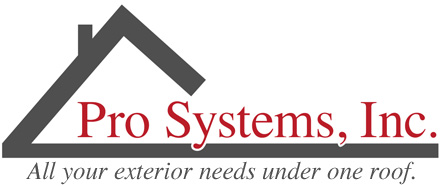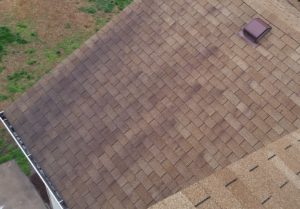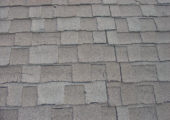We’ve all seen those black streaks on shingle roofs that cause them to look old and dirty. Sometimes mistaken for soot, mold, or mildew, typically the discoloration is caused by algae. Fortunately, the algae can be removed with a bleach solution. The most common type of roof algae is called Gloeocapsa Magma, although it’s not actually algae at all, it is cyanobacteria. Algae are single celled eukaryotes and are closer to plants. Cyanobacteria are photosynthetic bacteria that are about 3 billion years old, and were responsible for the oxygen in the atmosphere.
Gloeocapsa Magma arrives on roofs through the air, and requires a moisture-rich environment, usually with shade, dew, and humidity. Typically, roof algae show up beneath trees and on the north facing sides of a roof, which receives less light. Because algae travel through the air, if one neighbor has roof algae, soon the whole neighborhood will. Roof algae thrive on shaded shingle roofs because they feed on calcium carbonate found in asphalt shingles. They produce a dark pigment to protect the cells from the sun, acting like sunblock. That’s why your roof turns black and not green. This can cause the roof to reflect less and absorb more sunlight, which can cause higher temperatures in your home, raising cooling costs.
These organisms are often the first in a succession of organisms that can weaken your roof. When roof algae and fungi team up, they form lichen. Moss, if the roof is shaded and moist enough, can then follow, which can cause the corners of the shingles to curl. Over time, the moss can build a small layer of soil that can possibly allow grass and other plants to grow. By this point, the shingles are well past their service life.
Fortunately, that process takes years to occur, and can easily be prevented. Keeping your tree branches trimmed back away from your roof will help prevent the conditions necessary for moss and such to grow. As long as your roof does not form moss, it will most likely perform according to its rated lifespan. Roof algae is typically just an aesthetic annoyance, but can be removed with a bleach solution. It is recommended that you combine one cup of trisodium phosphate with one gallon of bleach and five gallons of water. Spray the solution over the affected areas on your roof, let it sit for 20 minutes, and then rinse with a soft pressure hose. Do not use high pressure on your roof, as it may cause damage.
Algae resistant shingles are becoming more popular and almost standard. They work by strategically placing copper granules with the asphalt granules. Copper, zinc, and aluminum all stop roof algae growth. The copper granules are placed so that the color remains consistent through the entire shingle and roof, but also allows maximum coverage on the roof to prevent algae growth.
In short, black streaks are caused by roof algae, most commonly Gloeocapsa Magma, and by themselves, are not harmful to your roof. The only problems they cause are cosmetic. You can treat it fairly easily yourself or hire your local pressure washing company to take care of it for you. If you see green moss on your roof, remember that can cause your roof to deteriorate and should be taken care of as soon as possible.




Comments are closed.